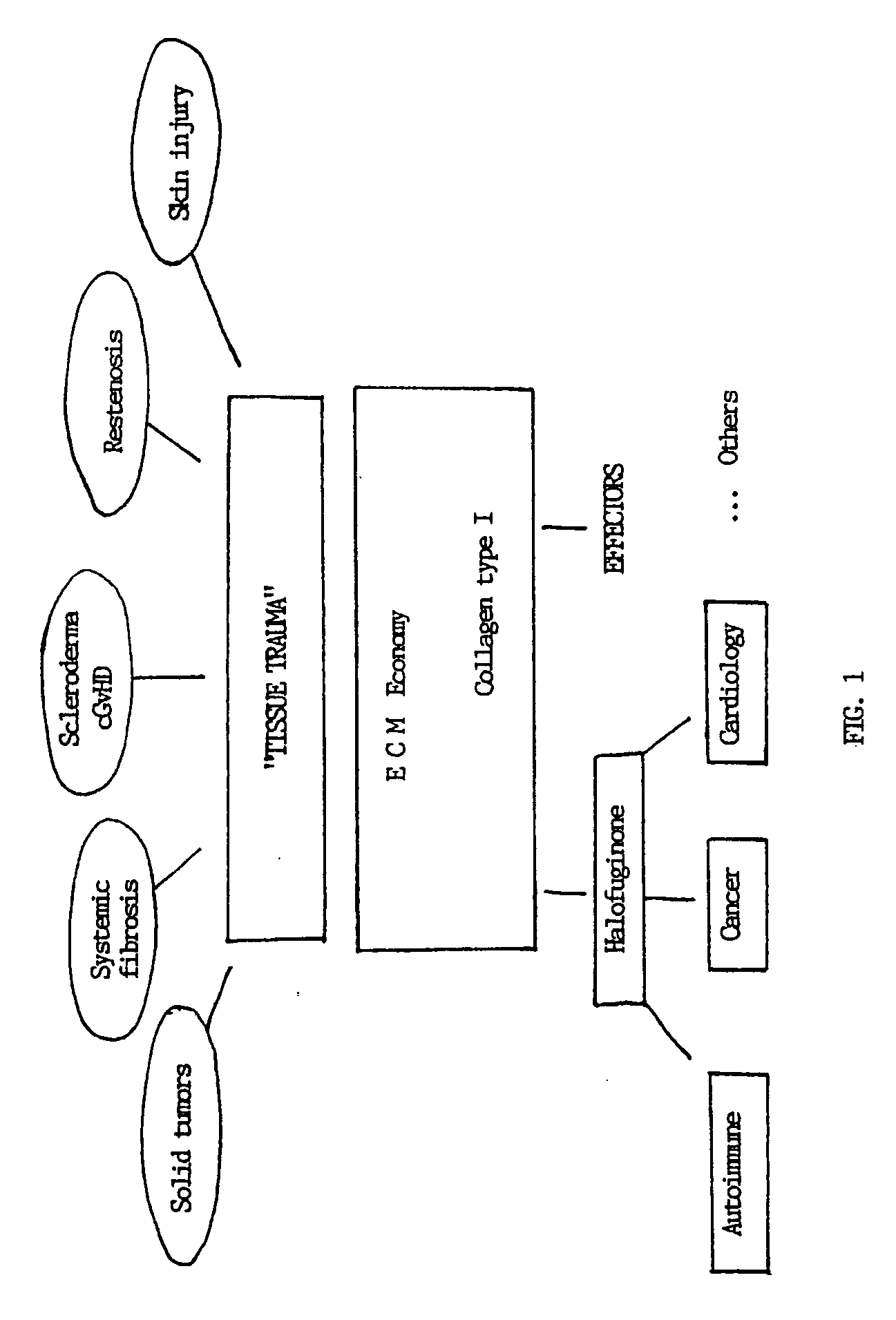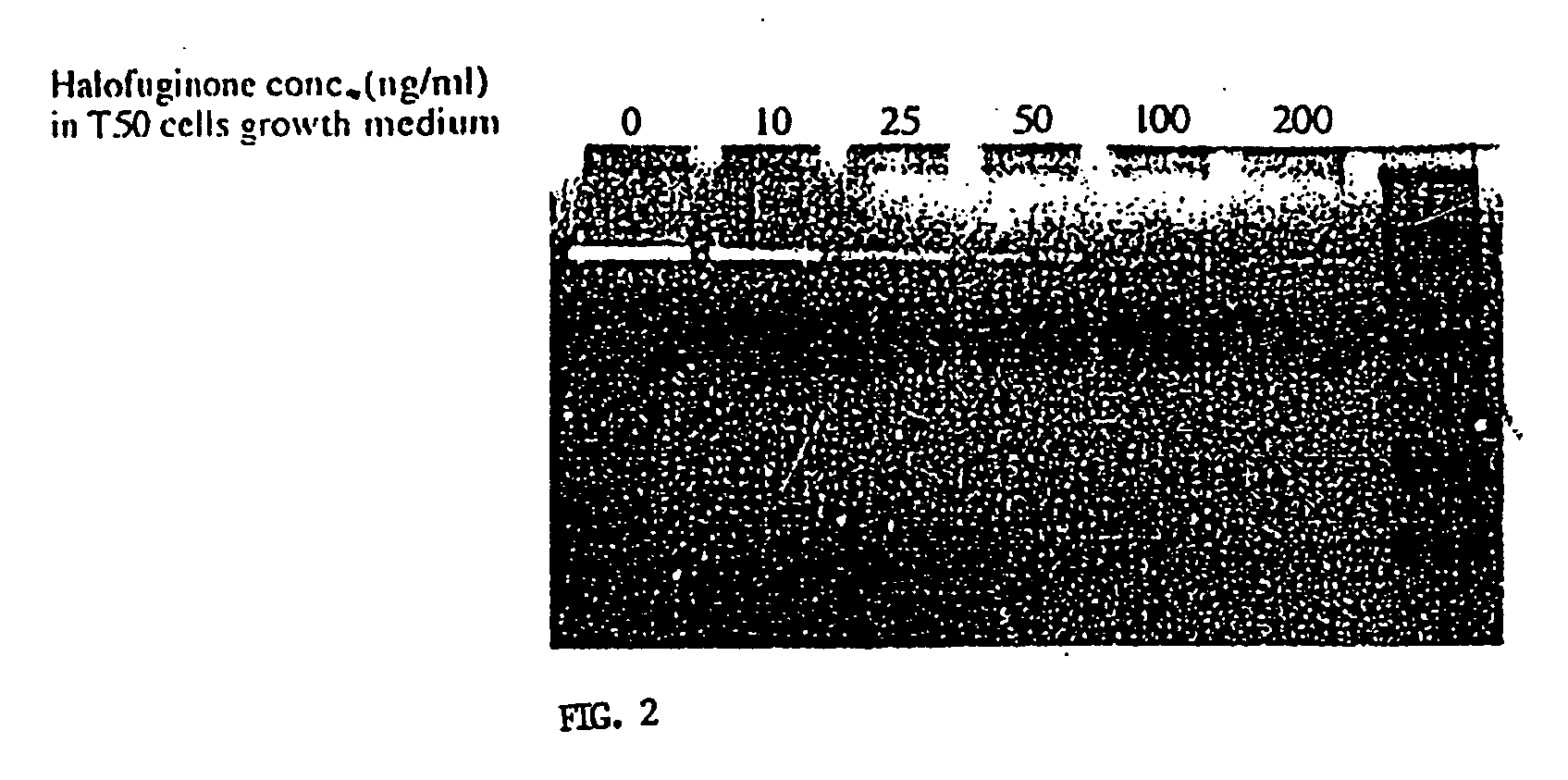Inhibition of pathogenic processes related to tissue trauma
a tissue trauma and pathogenic technology, applied in the field of tissue trauma inhibition, can solve the problems of cardiac fibrosis and other types of fibrotic disease processes, the treatment of various abnormal responses to tissue trauma, and the death of patients, etc., and achieves the effects of reducing the ability of the heart to function, reducing the number of patients, and increasing the risk of recurren
- Summary
- Abstract
- Description
- Claims
- Application Information
AI Technical Summary
Benefits of technology
Problems solved by technology
Method used
Image
Examples
example 1
Promotion of cKrox Activity and Inhibition of Collagen Type I Gene Expression by Halofuginone
[0090] As noted previously, one of the most important targets for the action of Halofuginone and other related quinazolinones and effectors is the promotion of cKrox activity and the concomitant inhibition of collagen type I gene expression. These two activities were demonstrated with Halofuginone as follows.
[0091] First, the ability of Halofuginone to inhibit collagen type I gene expression was demonstrated as follows. Myometrial and leiomyosarcoma cells were taken from the same patient and were plated into 10 cm plates in DMEM supplemented with 10% FCS. When the cells reached 80% confluence, the medium was replaced by serum free DMEM plus 0.1% BSA for 48 hours, washed and exposed to increasing concentrations of Halofuginone in the same medium for about 48 hours at about 37° C. The cells were then harvested and subjected to RNA extraction and Northern blot analysis for collagen type I gen...
example 2
Inhibition of Type IV Collagenase Production by Halofuginone In Vitro
[0094] Another important feature of the regulation of the extracellular matrix economy is the inhibition of type IV collagenase production by Halofuginone.
[0095] Tumor cells secrete enzymes which digest the ECM, enabling the cells to burrow through neighboring tissue and to invade other tissues. Numerous studies have linked matrix metalloproteases (MMP), especially type IV collagenase, to the process of tumor invasion and metastasis. Type IV collagenase appears as two 72 and 92 kDa proteins encoded by a unique mRNA.
[0096] As demonstrated in FIG. 2, a profound inhibition of the activity of MMP2 (72 kDa type IV collagenase) in T50 bladder carcinoma cell cultures was exerted in the presence of 25 ng / ml Halofuginone, while an almost complete inhibition was obtained at 100 ng / ml Halofuginone. Sub-confluent cell cultures were incubated for 6-24 h in serum-free DMEM. The collagenolytic activity was determined on a gela...
example 3
Inhibition of Tumor-Marker Gene Expression by Halofuginone In Vitro
[0098] Yet another aspect of the extracellular matrix economy is the regulation of tumor-marker gene expression, and in particular of the inhibition of the expression of the H19 gene.
[0099] The H19 gene is a developmentally regulated gene whose expression peaks during fetal development when tissue differentiation is occurring. The H19 gene is parenterally imprinted, expressed only by the maternal allele. H19 is also a tumor-marker gene, associated with early stages of malignancies such as Wilms' tumor, adrenocortical carcinoma, hepatoblastoma, rhabdomyosarcoma, lung tumors, trophoblastic tumors and bladder carcinoma. The experimental method was as follows.
[0100] RT112 and 5376 human bladder carcinoma cell lines were cultured in the absence and presence of Halofuginone (130 ng / ml, added 24 h or 72 h after seeding), and the expression of the H19 gene was evaluated by Northern blot analysis (Nagler, A. et al., Arteri...
PUM
| Property | Measurement | Unit |
|---|---|---|
| concentrations | aaaaa | aaaaa |
| concentrations | aaaaa | aaaaa |
| concentrations | aaaaa | aaaaa |
Abstract
Description
Claims
Application Information
 Login to View More
Login to View More - R&D
- Intellectual Property
- Life Sciences
- Materials
- Tech Scout
- Unparalleled Data Quality
- Higher Quality Content
- 60% Fewer Hallucinations
Browse by: Latest US Patents, China's latest patents, Technical Efficacy Thesaurus, Application Domain, Technology Topic, Popular Technical Reports.
© 2025 PatSnap. All rights reserved.Legal|Privacy policy|Modern Slavery Act Transparency Statement|Sitemap|About US| Contact US: help@patsnap.com



